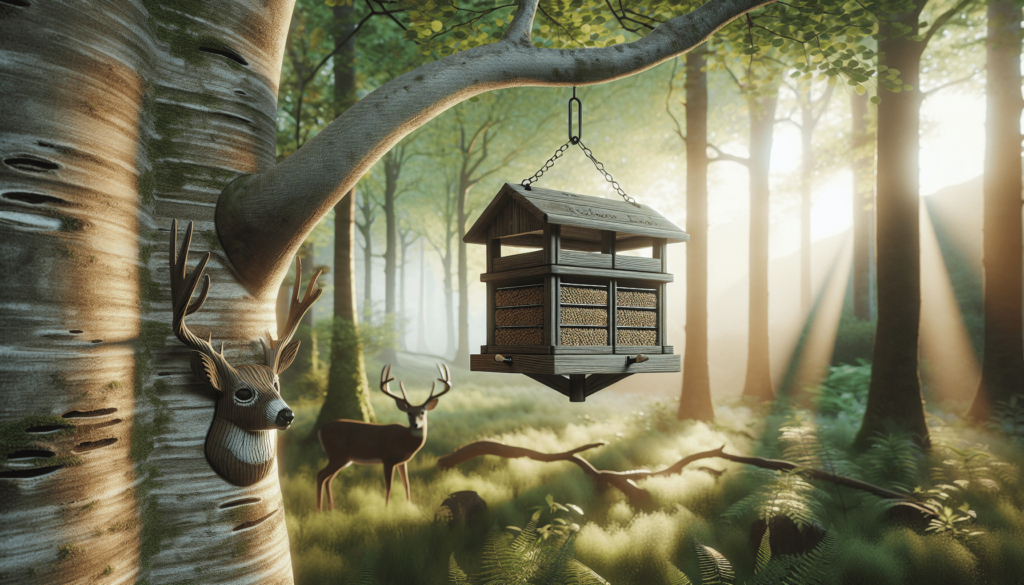
Have you ever wondered how to attract more deer to your hunting grounds or backyard? If so, you’re not alone. Many enthusiasts find joy and utility in creating a deer-friendly environment, and one of the most effective methods is using hanging deer feeders. This beginner’s guide will walk you through everything you need to know about attracting game with hanging deer feeders.
Understanding the Purpose of Deer Feeders
Deer feeders are used for several reasons, but primarily they are designed to attract and provide consistent nutrition to deer in a specific area. By setting up a feeder, you can effortlessly make your property hospitable to game, increasing your chances of success during hunting season.
Why Hanging Deer Feeders?
Hanging deer feeders have a significant advantage over ground feeders: they minimize the risk of feed contamination and keep pests like raccoons and rodents at bay. Elevated off the ground, these feeders provide a cleaner, more efficient feeding station that deer are more likely to frequent.
Types of Deer Feeders
There are various types of deer feeders available on the market, but here we will concentrate on hanging deer feeders. These can be broadly categorized into gravity-fed feeders and automatic feeders, each with its unique benefits and drawbacks.
Gravity-Fed Feeders
Gravity-fed feeders work on a simple principle: gravity pulls feed down into a feeding tray or tube. They are easy to set up and maintain, making them ideal for beginners. However, they might require periodic refilling based on deer activity.
Automatic Feeders
Automatic feeders are more advanced and come with timers and dispensers to regulate feed release. They can be programmed to dispense feed at specific times of the day, making them more efficient in managing feed distribution. This type can be more technologically complex but offers greater control over feeding schedules.
Choosing the Right Deer Feeder
The market is flooded with different brands and models of hanging deer feeders. To simplify your selection process, here are some key factors to consider:
Capacity and Load
The capacity of the feeder is crucial. Depending on the deer population and frequency of feeding, you’ll want to choose a feeder that can hold an adequate amount of feed. Brands like Moultrie and Boss Buck offer models with various capacities to meet different needs.
Material and Durability
The material of the feeder plays a significant role in its longevity. Feeders made from high-quality, weather-resistant materials are more durable and require less maintenance. Brands such as Highwild and On Time Wildlife Feeders are known for their sturdy construction.
Ease of Use and Installation
Installation can be a hassle if the feeder isn’t designed for easy setup. Look for feeders that come with clear instructions and necessary hardware for hanging. Gravity Fed and SolutionsPatIQ provide user-friendly models that simplify the installation process.
Feeding Mechanism
As mentioned earlier, you can choose between gravity-fed and automatic feeders. Moultrie and American Hunter offer both options, allowing you to pick one that suits your requirements best.
Price Point
While it’s tempting to go for the cheapest option, investing in a quality feeder from reputable brands like WILDGAME INNOVATIONS or Keilyn can save you money in the long run due to their durability and efficiency.

Setting Up Your Deer Feeder
Once you’ve selected the right feeder, the next step is setting it up correctly to attract game. The following tips will guide you through the process.
Location Selection
Choosing the right location for your deer feeder is critical. Deer prefer secluded, quiet areas away from human activity. Look for spots with natural cover such as bushes or trees, which can provide deer with a sense of security.
Height and Accessibility
Hang the feeder at a height where deer can easily reach the feed, but pests and other wildlife cannot. Typically, a height of 4 to 5 feet off the ground is ideal.
Timing and Consistency
If you’re using an automatic feeder, set the timers to dispense feed during dawn and dusk — the times when deer are most active. Consistency in feeding times will help in forming a feeding routine for the deer.
Maintenance of Your Deer Feeder
Regular maintenance is essential for the effective operation of your deer feeder. Here are some maintenance tips:
Regular Cleaning
Clean the feeder periodically to remove old and moldy feed, which can deter deer and attract unwanted pests.
Check for Damage
Inspect your feeder for any wear and tear, especially if it’s made from plastic. Brands like Highwild and Andee often offer replacement parts, which can be handy.
Monitor Feed Levels
Keep an eye on the feed levels and replenish them as necessary. Automated feeders usually have indicators showing the remaining feed, making monitoring easier.
Seasonal Adjustments
Adjust your feeding schedule and feed type based on the seasons. During the winter, deer need high-energy foods like corn, whereas in the spring and summer, they may prefer protein-rich feeds.

Benefits of Using Hanging Deer Feeders
Using hanging deer feeders offers numerous benefits that extend beyond merely attracting deer. Here’s a closer look at why investing in these feeders can be a game-changer:
Increased Deer Activity
By providing a consistent food source, you’ll notice a marked increase in deer activity around the feeder, making your property a hotspot for hunting.
Better Nutritive Control
You can easily control the type and amount of feed, ensuring the deer get the nutrients they need. Brands like WILDGAME INNOVATIONS and KUMFJ offer specialized feeder options designed to deliver nutritionally balanced feed.
Enhanced Deer Health
When deer have access to a steady and nutritious food source, their overall health improves, which can lead to larger, healthier deer on your property.
Convenient Wildlife Management
Using automatic feeders allows you to manage wildlife more effectively. You can regulate feeding times, monitor deer activity, and make data-driven decisions to improve your hunting strategy.
Common Challenges and Solutions
While hanging deer feeders are highly effective, you may face some challenges. Here are common issues and how to address them:
Pest Infestation
Pests like squirrels, raccoons, and even birds can be drawn to your feeder. Choosing a sturdy feeder with pest-resistant features can minimize this problem. Brands like Boss Buck provide feeders with secure lids and barriers to keep pests away.
Weather Conditions
Extreme weather can impact your deer feeder’s performance. For instance, rain can spoil feed, while strong winds can damage the feeder. Opting for weather-resistant materials and secure installations from brands like SolutionsPatIQ can help mitigate these issues.
Inconsistent Deer Activity
If deer don’t seem interested in your feeder, it could be due to location or feed type. Experiment with different feeds and adjust the feeder’s height and placement until you find the most effective setup.
Overfeeding or Underfeeding
Automatic feeders help you regulate feed distribution, but setting them up incorrectly can lead to overfeeding or underfeeding. Refer to the manual provided by brands like American Hunter or On Time Wildlife Feeders to optimize the timer and feed quantity settings.
Intruding Wildlife
Sometimes larger animals like bears or hogs might be attracted to your feeder. Employing a high-durability feeder from professionals such as Highwild can withstand the intrusion better, ensuring your setup remains intact.
Popular Brands and Models
Here’s a quick comparison of some popular brands and their standout models to help you make an informed decision:
| Brand | Model | Type | Capacity | Special Features |
|---|---|---|---|---|
| Moultrie | Pro Magnum Feeder | Automatic | 30 gallons | Timer control, durable design |
| American Hunter | Sun Slinger Feeder | Automatic | 6.5 gallons | Solar-powered, programmable |
| WILDGAME INNOVATIONS | Quick Set 50 Feeder | Gravity-fed | 50 lbs | Easy setup, weather-resistant |
| SolutionsPatIQ | Steel Gravity Feeder | Gravity-fed | 100 lbs | Sturdy, large capacity |
| Highwild | Heavy Duty Feeder Kit | Automatic | Variable | Robust construction, versatile |
| Boss Buck | Triple Threat Feeder | Automatic | 200 lbs | Multi-feed options, wildlife resistant |
| On Time Wildlife Feeders | Elite Feeder | Automatic | 150 lbs | Digital Timer, easy-to-use |
| Gravity Fed | Pro Series | Gravity-fed | 120 lbs | Large capacity, easy refill |
| Keilyn | Deluxe Deer Feeder | Automatic | 40 gallons | Smart timer, durable |
| Andee | Basic Gravity Feeder | Gravity-fed | 75 lbs | Easy maintenance, cost-effective |
| KUMFJ | Pro Hunter Feeder | Automatic | 30 gallons | Weather-resistant, programmable |
Setting Up Your Feeder for Seasonal Variance
Different seasons require different strategies for maintaining and using your deer feeder. Here’s a brief look at how to adapt:
Spring and Summer
During these months, deer require more protein for antler growth and nursing. Use protein-rich feeds and set your feeder to dispense smaller amounts more frequently. Ensure that the feeding area is shaded to keep the feed from spoiling.
Fall
This is the pre-rut and rut season when deer need more energy-dense foods, like corn, to prepare for the winter. Increase the quantity of feed but reduce the frequency to ensure it lasts longer and meets the deer’s energy needs.
Winter
In winter, deer struggle to find food. Having your feeder dispense larger quantities of high-energy food can help maintain their health. Keep an eye on snow accumulation, which can block access to the feeder.
Legal Considerations
Before setting up your deer feeder, it’s crucial to be aware of local laws and regulations. Some areas have strict guidelines about feeding wildlife, particularly during certain seasons. Always check with local wildlife management authorities to ensure your feeder complies with regulations.
Conclusion
Setting up a hanging deer feeder can revolutionize your game-attracting efforts. From increasing deer activity to improving wildlife health, the benefits are extensive. By choosing the right feeder, setting it up correctly, and maintaining it efficiently, you’ll not only attract more deer but also contribute positively to their well-being.
Remember to consider the specifics that suit your needs—whether it’s the capacity, ease of installation, or special features of a particular model. With reputable brands like Moultrie, American Hunter, and WILDGAME INNOVATIONS at your disposal, you are well on your way to creating a thriving deer-friendly environment.



